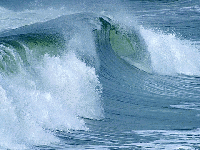At a time when coal generation is being phased out and electricity
demand is on the rise, utilities are increasingly shifting energy policy
to a focus on renewable sources.
Solar and wind dominate the discussion, and both industries are
enjoying rapid growth. Water can also be a powerful source of energy;
however it is often left out of the discussion and is ripe for
development. Renewable energy critics are quick to point out that
wind doesn't always blow and the sun sets, but water rarely dries up. It
covers the majority of the Earth, and converting its kinetic energy into
electricity looms as an energy security and reliability game-changer.
Many people think of traditional hydropower as nothing more than
a dam and a turbine, but this is changing. Modern technology is
capable of harnessing tidal movement as well as deep ocean wave
energy, and the industry is beginning to break into utility-scale
projects.
"It's a really exciting time," said Chad Marriott, an energy
development attorney, speaking at the recent RETECH conference in
Washington, D.C. "We have a lot of really smart people with great
ideas and the end goal is to get commercial deployment of devices
that will make some money."
The U.S. is endowed with significant hydropower potential with
about 96,000 megawatts of conventional hydropower capacity as of
2009, according to the Department of Energy. The Federal Energy
Regulatory Commission has approved 15 new hydro projects approved so
far for 2012, and it's estimated that the U.S. overall has the
potential for 1,200 terawatt hours of wave energy alone.
______________________________
Many people think of traditional hydropower as
nothing more than a dam and a turbine, but this is changing.
___________________________ |
Regulatory and testing hang-ups
In the U.S., hydropower licensing falls under FERC jurisdiction.
In addition, the Bureau of Ocean Energy Management is responsible
for all offshore renewable energy programs, including grants, leases
and easements. BOEM also conducts environmental reviews for offshore
renewable projects. In July 2012, two organizations jointly
announced new regulations for marine and hydro kinetic proposals.
It's a key part of an evolving effort to make hydro project
development more affordable and prevalent.
"We are trying to promote a more efficient process for
authorizing these types of research and testing activities," said
Robert Labelle, senior advisor to the director at BOEM.
Ann Miles, deputy director of FERC's Office of Energy Projects,
praised what she sees as procedural certainty and concrete timelines
complex hydro project applications, and solid progress in adapting
to small-impact projects such as irrigation canals and water supply
pipes. Some of these have been approved in as few as two months.
With that in mind, there are still regulatory challenges to
tackle.
"We have this conundrum of needing to get some projects in the
water to be able to test the technology, test the energy resource
and test the environmental effects. Yet we didn't have enough
information to do the environmental reviews to get there," Miles
noted.
In an effort to solve this problem, the U.S. Department of Energy
this year announced the $4 million Pacific Marine Energy Center, an
open sea test facility for wave-energy technology that will allow
developers to turn prototypes into grid-scale applications.
Partnership opportunities
The U.S. only need look north to get a glimpse of the robust
potential of hydropower. Canada gets 60 percent of its entire
generation from hydro sources (more than eight times the United
States' 7 percent), according to Jacob Irving, President of the
Canadian Hydropower Association.
Speaking at RETECH, he highlighted Canada's 74,000 megawatt
hours of installed hydropower capacity, but noted also that the
country has another 163,000 megawatts of still undeveloped
generation potential. Irving said Canada is also working to raise
awareness and support of a power interconnection with the United
States.
"We support each other, and as you can see, Canada has the
potential to help out a whole lot more," he said. "All that we
require is a signal from U.S. customers that there is interest in it
and we'll be there."
